
PUMPA - SMART LEARNING
எங்கள் ஆசிரியர்களுடன் 1-ஆன்-1 ஆலோசனை நேரத்தைப் பெறுங்கள். டாப்பர் ஆவதற்கு நாங்கள் பயிற்சி அளிப்போம்
Book Free DemoMorphology is the study of form or structure of an organism.
Leeches are segmented worms. It has all the necessary sensory receptors and organs on its body for the survival.
The external characteristic feature of the leech is discussed in this object.
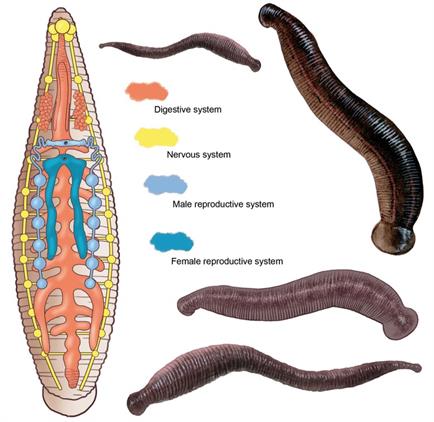
Internal and external structure of Hirudinaria
Habit and Habitat of Indian cattle leech:
- Habit refers to characteristic shapes and behavior of the organism.
- Habitat refers to the natural environment of the organism.
Distribution:
Hirudinaria granulosa (Indian Cattle Leech) is distributed in the countries viz., India, Bangladesh, Pakistan, Myanmar and Srilanka.
Habitat:
Habitat:
Similar to the majority of the leeches, Indian cattle leeches also lives in freshwater areas such as ponds, lakes, swamps and slow streams.
Parasitic nature:
Parasitic nature:
It is parasitic since it lives by feeding the blood from fishes, frogs, cattle and humans. As they live on the external body of the organism, it is called an ectoparasite.
Important!
Note: Due to its blood sucking nature, it is called sanguivorous.
External morphology:
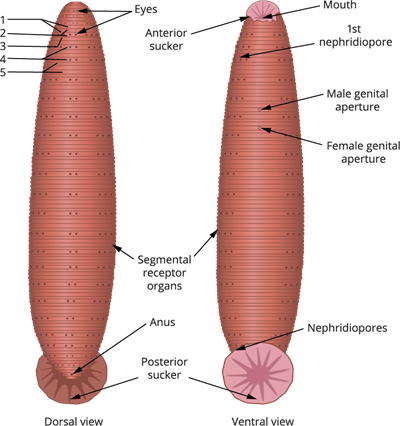
External morphology of leech: Left to right: Dorsal view and ventral view
We should understand certain terminology and their meanings before learning about the external morphology of leech.
Nomenclature:
|
|
|
|
|
Size:
Leeches could grow to a length of \(35\)cm.
Shape:
A leech has a soft, vermiform, elongated, and segmented body. When extended, it takes on a ribbon shape, and when contracted, it takes on a nearly cylindrical shape.
Colouration:
- Colour of the dorsal surface of the leech - Olive green
- Colour of the ventral surface of the leech - Orange yellow or orange red
Segmentation:
Since the leeches comes under the phylum Annelida, their body is segmented, which is shown in the above diagram. This division of body into linear segments is called as metamerism.
Metamerism is the feature of a linear series of body segments with fundamentally similar structures, yet not all of them are identical in any single life form since some of them have specific functions.
The body of a leech is divided into \(33\) segments metamerically. The segments are stacked on top of each other. Each segment is further segmented into rings or annuli on the surface.
Important!
On segments \(9-11\), a temporary clitellum is developed, which is intended to build a cocoon during the breeding season.
Receptors:
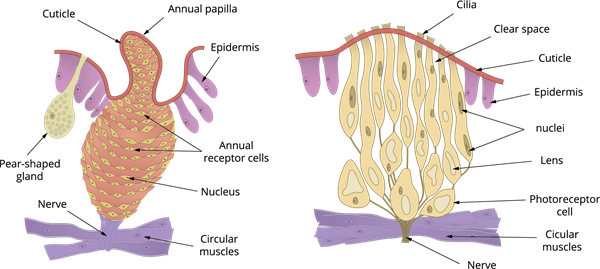
Left to right: Structure of annular and segmental receptors
The first five segments on the dorsal side have five pairs of eyes. Each segment has a number of receptors, which are sensory projections. Each annulus contains annular receptors, while the first annulus of each segment has segmental receptors.
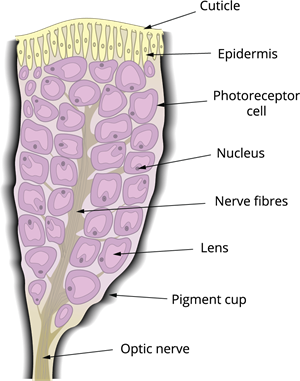
Longitudinal section of an eye
Suckers:
Leech has two suckers on its body. The anterior sucker, also known as the oral sucker, is a ventral sucker that occupies the first five segments and is placed at the anterior end.
The union of the last seven segments forms the posterior sucker. The anterior sucker aids in feeding, while the suckers on both sides aid in attachment and locomotion.
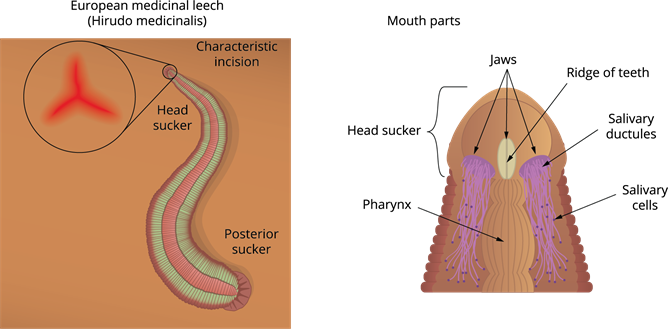
The anatomy of leech sucker
Important!
The external apertures present in the leeches is explained in the next object.
Reference: